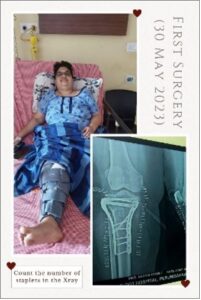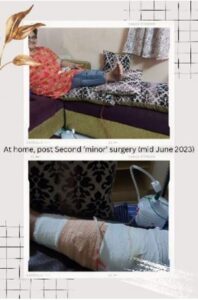
Invisible Disability and Intersectionality – Part 1
Last year-and-a-half has been quite a healing journey I went through on self-discovery, as I was recovering from major surgery in my right leg, because of a hit-and-run road accident I met within May 2023. Though I have almost regained 95% of my mobility and that my injury (or part-disability) is not externally visible, except maybe for my occasional pauses or limps when I walk, this has been a life-changing event for my physical & mental health. This recuperation journey helped me realise the various layers in action with respect to hidden disability and its broader impact on an individual and family’s mental health.
The Surgery & Post-op recovery

I had a complex proximal tibial fracture on my right leg, that needed immediate surgical intervention. The recovery and rehab timeframe as indicated by the doctor was about 1.5 - 2 years. Today, I have reached close to 100% range of movement and 95% mobility.
Recovery itself was quite complicated when one of the three surgical incisions became infected 2 weeks into post-op recovery, leading me into another minor operative procedure including re-suturing. This extended my recovery time by over a month, to start my partial weight-bearing rehab physiotherapy. Alongside this, I also managed to launch my first (collaborative) book on Parenting. By Nov 2023, I was ready to be taught to start climbing stairs. The pain was extreme, but I persevered.
Onset of Perimenopause
Well into my rehabilitation journey, I noticed a pattern of anxiety as a common occurrence in the week before my menstrual cycle (which also has a reduced duration in comparison to what it used to be in my 30s), especially before my night sleep.
There are other perimenopausal symptoms that I started experiencing, which I am not enlisting here. Suffice it to say, in the recent times there is enough talk about its related symptoms, where some mention that there are close to 100+ (but nothing less than 20) symptoms. So, this is prone to the risk of being misdiagnosed, as there has not been sufficient research to ascertain the specific symptoms with scientific validation & reliability.
On hindsight, after multiple visits to the endocrinologist, followed with a visit to a general physician to affirm that the changes, including the critically high blood pressure, I recognised that it is a result of the complex stress, which is a result of the everyday stress from the different roles I play, the complications to my personal health (from the accident, recovery and rehabilitation), combined with the perimenopausal phase.
What I read as part my Abnormal Psychology, under the category differential diagnosis, I have come to experience, specific to my case, that not all medical professionals or any other support professionals (physiotherapists, counsellors, therapist, spiritual coach, healers) make a holistic evaluation before planning the intervention. In many cases, active listening seems lacking, and the professionals rush to diagnosis and intervention based on a few symptoms or markers. The mitigating circumstances, the chronic stress factor (especially in women and primary care givers, and those belonging to the ‘sandwich’ generations including men who experience the pressure of sustaining the income as their household might be a single income household), and any other confounding factors exacerbating the physical, physiological, and mental symptoms as referenced in a diagnostic manual, are not taken into consideration while arriving at a definitive diagnosis.
professionals or any other support professionals (physiotherapists, counsellors, therapist, spiritual coach, healers) make a holistic evaluation before planning the intervention. In many cases, active listening seems lacking, and the professionals rush to diagnosis and intervention based on a few symptoms or markers. The mitigating circumstances, the chronic stress factor (especially in women and primary care givers, and those belonging to the ‘sandwich’ generations including men who experience the pressure of sustaining the income as their household might be a single income household), and any other confounding factors exacerbating the physical, physiological, and mental symptoms as referenced in a diagnostic manual, are not taken into consideration while arriving at a definitive diagnosis.
Rush to Judgment & Blame Shifting (especially by care professionals)
When I was in the hospital during post-op recovery, the nursing team attending to me was judgmental with remarks of me overthinking or sighting my obesity as a reason for my high BP and for the difficulty in finding a vein, instead of seeing it as a deep-seated vein body anatomy or the trauma, and my luteal & menstruating phase of my menstrual cycle impacting the changes in my BP. Even after 18 months of my accident, it is a mental (& emotional) project plan for me, every time I step out of my home to visit family, friends, or go to a mall or movie. Any crowded place or navigating in peak traffic (even inside an auto or a cab) brings back the full-blown anxiety. There are days I find myself feeling the strong urge to cry out loud, but refrained from doing so as I was conditioned in my developmental years that letting the tears flow was a sign of weakness. I have now understood otherwise. All these also contributed to my high BP, anxiety and fatigue.
During this difficult phase, I was greatly thankful to my family (spouse & children), to whom I freely express my vulnerabilities. They understand me better and can hold a safe space for me to be myself, breaking the toxic expectation that, as a mother, I have to stay strong, even if it is costing me my wellbeing.
To know what my recovery journey looked like and to understand the importance of intersectionality one’s holistic wellbeing, look out part for part 2 of this article.
